Have you ever wondered how a single piece of art can bridge centuries of history and culture? The rediscovery of a long-hidden treasure by Juan Luna has brought this question to life. This historic gift, now a centerpiece of the National Museum, is a testament to the enduring legacy of one of the Philippines’ most celebrated artists.
For decades, this masterpiece remained out of public view, its story untold. Today, it stands proudly among the nation’s most cherished artifacts. The National Museum has made it its mission to preserve and showcase such treasures, ensuring they remain a source of pride for generations to come.
This rediscovery is more than just an artistic triumph; it’s a celebration of Filipino identity. It reminds us of the power of cultural heritage to connect us to our past and inspire our future. As you explore this article, you’ll uncover the story behind this remarkable piece and its significance in the narrative of the Philippines.
Key Takeaways
- The rediscovery of a historic gift by Juan Luna highlights the importance of preserving cultural heritage.
- This masterpiece is now a key part of the National Museum’s collection.
- Juan Luna’s legacy continues to inspire Filipino pride and identity.
- The National Museum plays a vital role in safeguarding national treasures.
- Cultural heritage connects us to our past and shapes our future.
Introduction
Art has the unique ability to transcend time, connecting generations through its stories. This is especially true for the works of a celebrated Filipino artist whose life and creations have left an indelible mark on history. His journey, filled with triumphs and challenges, reflects the evolution of Philippine art during a pivotal era.
Born in the 19th century, he emerged as a key figure in the Propaganda Movement, using his talent to elevate Filipino identity on the global stage. His works, such as the iconic “Spoliarium,” earned international acclaim and became symbols of national pride. These masterpieces not only captured moments in time but also conveyed powerful cultural messages that resonate to this day.
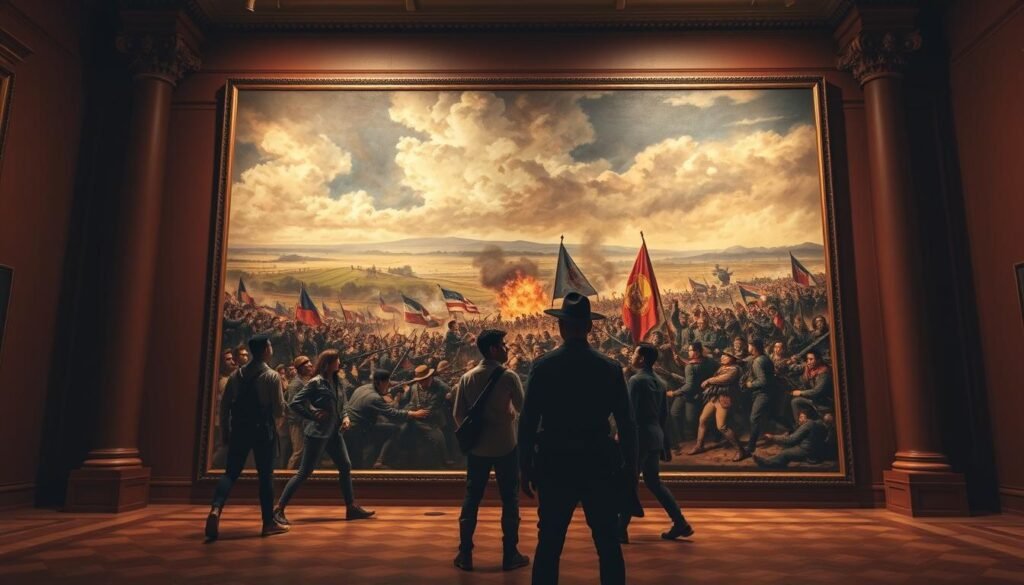
Art, as a medium, has the power to outlive its creators. It serves as a bridge between the past and the present, offering insights into the life and struggles of those who came before us. In the context of Philippine history, his contributions played a crucial role in shaping the nation’s cultural identity.
The historical backdrop of his era was marked by colonial influences and a growing desire for independence. His works, deeply rooted in this context, reflect the aspirations and resilience of the Filipino people. Through his art, he not only documented history but also inspired future generations to embrace their heritage.
As we delve deeper into his story, we uncover the profound impact of his legacy. His achievements remind us of the enduring power of art to inspire, educate, and unite. This article explores his journey, his masterpieces, and the timeless messages they carry.
Juan Luna: The Master Painter
Few artists have left a mark as profound as those who blend skill with cultural storytelling. Recognized as one of the first master painters from the Philippines, his work continues to inspire generations. His journey began with formal training in Europe, where he honed his craft and developed a unique style that set him apart.
Under the influence of European masters, his technique evolved, blending classical methods with innovative approaches. This fusion allowed him to create pieces that were both technically brilliant and deeply meaningful. His ability to capture emotion and narrative in his work earned him international acclaim.
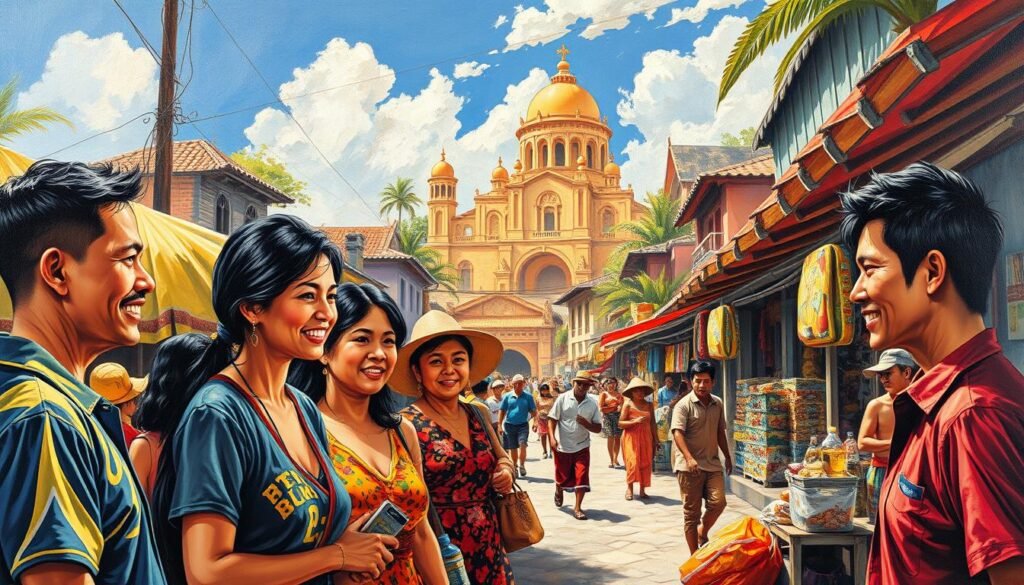
One of his most celebrated pieces, “Spoliarium,” is a testament to his genius. This monumental work won the First Class Medal at the 1884 National Fine Arts exhibition in Madrid. Its dramatic composition and powerful themes resonated with audiences, cementing his reputation as a visionary painter.
Another notable piece, “La Muerte de Cleopatra,” showcased his ability to blend historical storytelling with artistic mastery. This painting earned a silver medal at the Exposición Nacional de Bellas Artes in Madrid, further solidifying his place in the art world.
| Work | Achievement | Year |
|---|---|---|
| Spoliarium | First Class Medal | 1884 |
| La Muerte de Cleopatra | Silver Medal | 1881 |
His innovative qualities continue to inspire art enthusiasts worldwide. From his technical precision to his ability to convey profound messages, his legacy remains a cornerstone of Philippine art. Through his masterpieces, he not only documented history but also shaped the cultural identity of a nation.
Early Life and Family Background
The roots of a great artist often lie in the environment that shaped their early years. Born in 1857 in Badoc, Ilocos Norte, the artist grew up in a family that valued education and creativity. His parents played a significant role in nurturing his artistic interests, providing him with the support he needed to explore his talents.
In 1861, the family moved to Manila, a bustling city that offered new opportunities for growth. This move proved pivotal, as it exposed the young artist to a vibrant cultural scene. The city’s rich history and diverse influences became a source of inspiration for his later works.
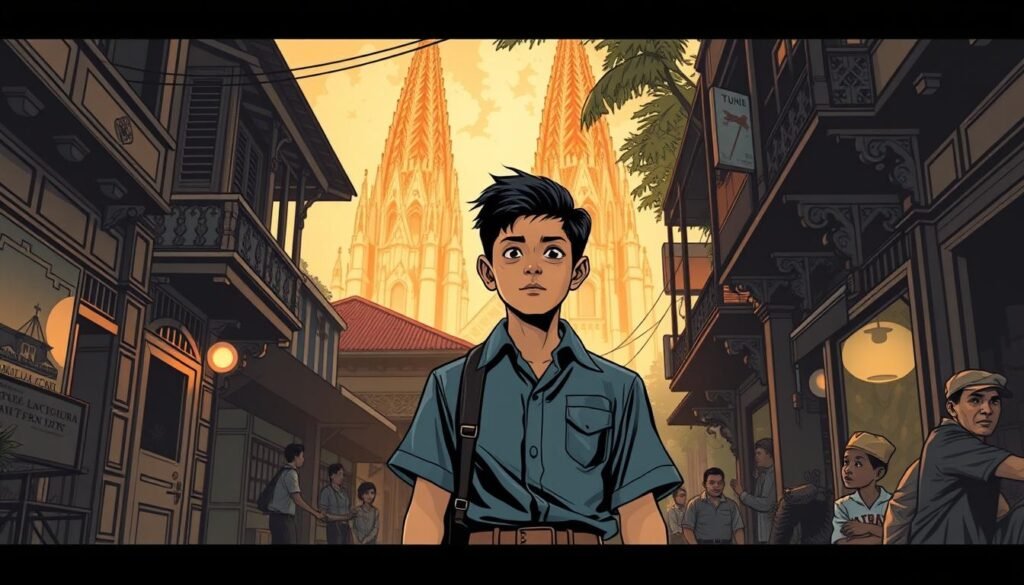
Childhood Influences and Roots
Growing up in a large family, the artist was the third of seven children. His upbringing was marked by a strong sense of community and shared values. These early experiences shaped his worldview and laid the foundation for his artistic journey.
The name Novicio, a reflection of his heritage, also played a role in his identity. It connected him to his roots and reminded him of the traditions that influenced his work. This sense of belonging would later become a recurring theme in his art.
Formative Artistic Training in the Philippines
In Manila, the artist received his early education, graduating with a Bachelor of Arts degree from Ateneo Municipal de Manila. This period was crucial in honing his skills and developing his unique style. The city’s artistic community provided him with the resources and mentorship he needed to grow.
His early training in the Philippines set the stage for his future success. It was here that he first discovered his passion for art and began to experiment with different techniques. This foundation would later propel him to international acclaim.
The Historical Landscape: Philippines and Spain in Focus
The intertwined histories of the Philippines and Spain have shaped artistic expression in profound ways. For over three centuries, Spanish colonial rule left a lasting imprint on Filipino culture, including its art. This period was marked by a blend of indigenous traditions and European influences, creating a unique artistic identity.
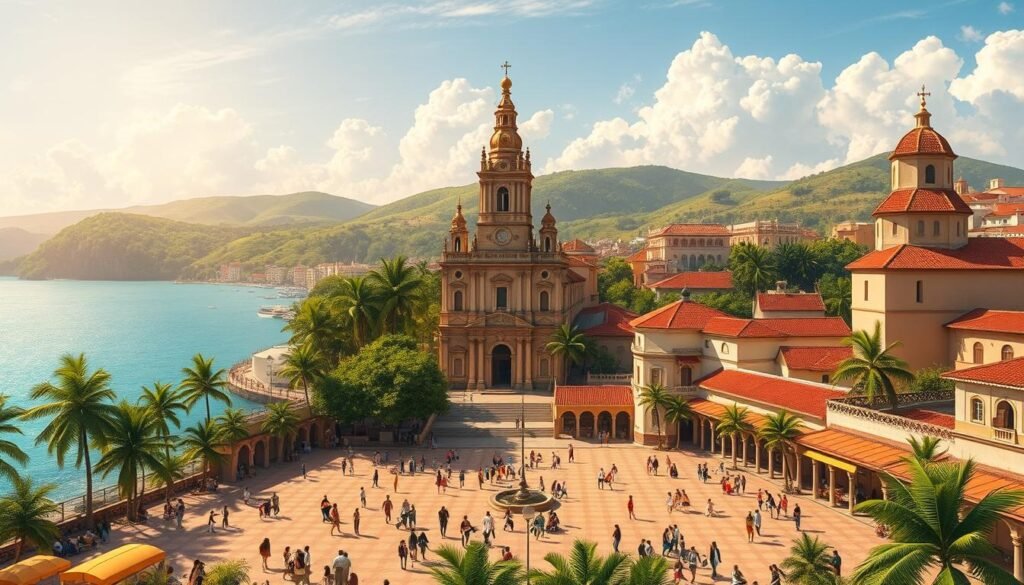
Spanish art academies played a significant role in shaping the skills of Filipino artists. Many traveled to Madrid to study under European masters, bringing back techniques that enriched local art. This cross-cultural exchange fostered a new era of creativity, blending classical methods with Filipino themes.
Colonial and Cultural Influences on Art
The colonial era introduced new artistic styles and mediums to the Philippines. Religious themes dominated, reflecting the influence of Catholicism. However, Filipino artists began to infuse their works with local narratives, creating a distinct voice that resonated with their heritage.
In Madrid, Filipino artists gained international recognition, showcasing their talent on a global stage. Their success not only highlighted their skill but also brought attention to the rich cultural heritage of the Philippines. This recognition played a crucial role in elevating Filipino art worldwide.
The legacy of Spanish colonial rule continues to influence Philippine art today. From architecture to painting, the fusion of styles serves as a reminder of the nation’s complex history. This blend of traditions remains a source of pride and inspiration for Filipino artists and audiences alike.
The Legacy of Blumentritt’s Gift
Artistic treasures, once lost, can resurface to tell tales of intellectual and cultural exchange. The gift from Ferdinand Blumentritt, a close associate of José Rizal, is one such treasure. Hidden for decades, this masterpiece now stands as a symbol of the deep connections between the Philippines and Europe.
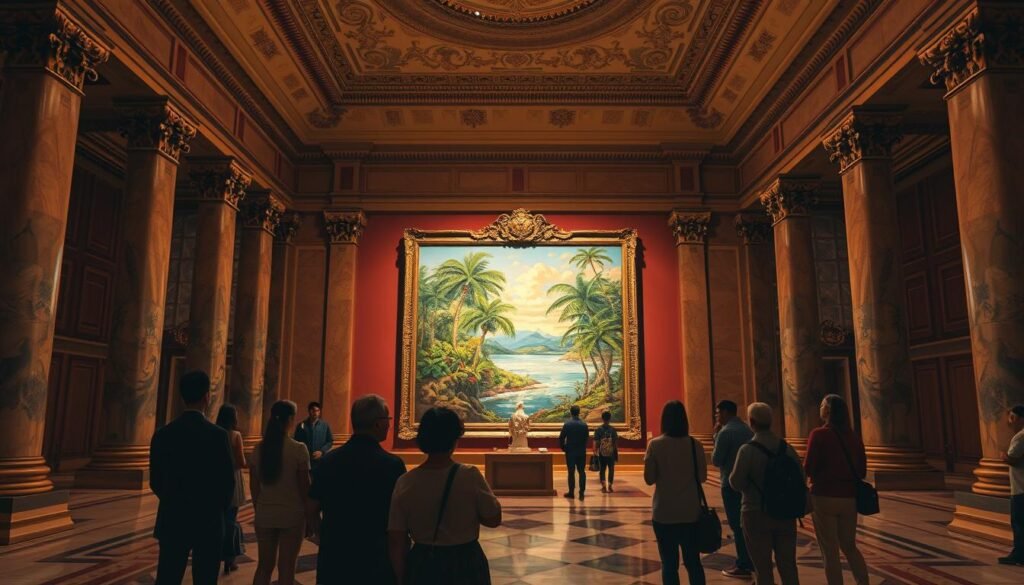
This gift holds immense cultural significance. It represents the intellectual exchange that flourished during the 19th century. Artists and thinkers from the Philippines and Europe collaborated, sharing ideas that shaped their respective cultures. The bellas artes movement played a pivotal role in this exchange, fostering creativity and innovation.
Cultural Significance and Intellectual Exchange
The re-emergence of Blumentritt’s gift highlights its importance in the international art community. Esteemed commissions by Filipino artists during this period underscore the prestige of such works. These pieces were often displayed in renowned galleries, including the National Museum and Museo del Prado, ensuring their preservation for future generations.
One notable example is the painting “Hymen, oh Hyménée!” which was authenticated and later loaned to the Ayala Museum. This masterpiece, like Blumentritt’s gift, reflects the artistic brilliance of its creator and the cultural ties it represents. Such works serve as reminders of the shared heritage between nations.
The legacy of Blumentritt’s gift extends beyond its artistic value. It embodies the intellectual exchange that continues to inspire Filipino heritage. By preserving and showcasing these treasures, institutions like the National Museum ensure that this legacy remains alive, connecting the past with the present.
Unveiling the Historic Gift: The Journey to the National Museum
The journey of a historic masterpiece often carries tales of resilience and cultural pride. This is especially true for the long-hidden gift that now finds its home in the National Museum. Its story is one of triumph, recognition, and the enduring bond between nations.
This masterpiece, a symbol of artistic brilliance, earned its creator a gold medal at the Madrid Exposición Nacional de Bellas Artes in 1884. This accolade not only celebrated the artist’s skill but also brought global attention to Filipino talent. Such honors validate the cultural and historical value of this treasure.
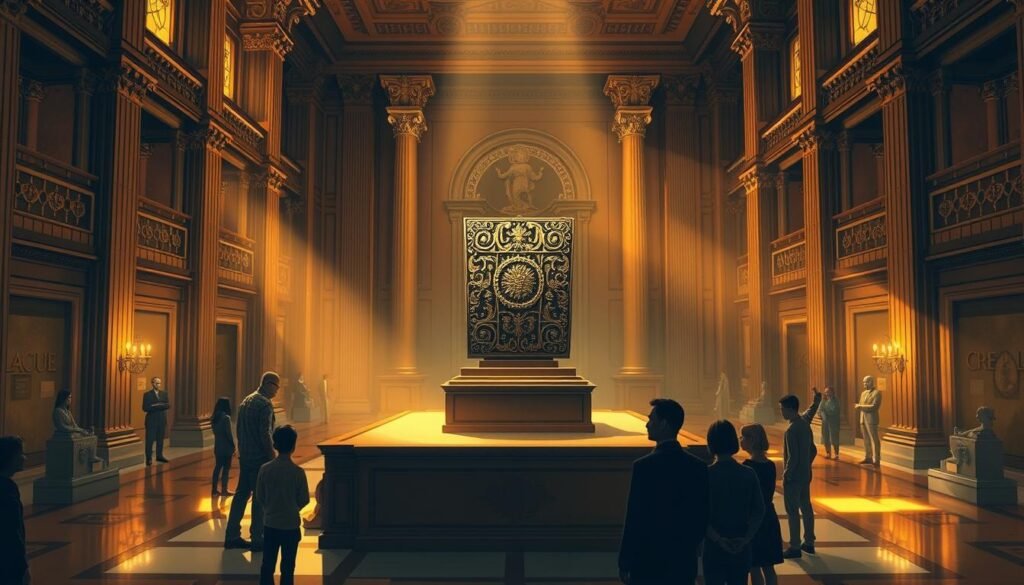
José Rizal, a national hero, held this artist in high regard. He admired the way the artwork captured the spirit of the Filipino people. Rizal’s admiration underscores the gift’s significance as more than just a piece of art—it’s a testament to national identity.
The journey of this masterpiece to the National Museum is a story of preservation and rediscovery. Hidden for decades, it resurfaced to remind us of the power of art to connect generations. Its permanent exhibition ensures that its legacy will inspire future audiences.
- The historic gift’s journey reflects resilience and cultural pride.
- Its creator’s gold medal highlights its international acclaim.
- José Rizal’s admiration emphasizes its cultural significance.
- Its rediscovery and exhibition ensure its enduring impact.
This masterpiece is more than an artistic achievement; it’s a symbol of Filipino heritage. Its journey to the National Museum is a celebration of art, history, and the connections that bind us all.
The Artistry Behind Signature Works
The brilliance of a masterpiece lies in its ability to tell stories that transcend time. Among the most celebrated works in Philippine arte, the “Spoliarium” and “The Death of Cleopatra” stand out for their technical mastery and thematic depth. These pieces not only showcase the artist’s skill but also reflect the cultural and historical narratives of the filipina identity.
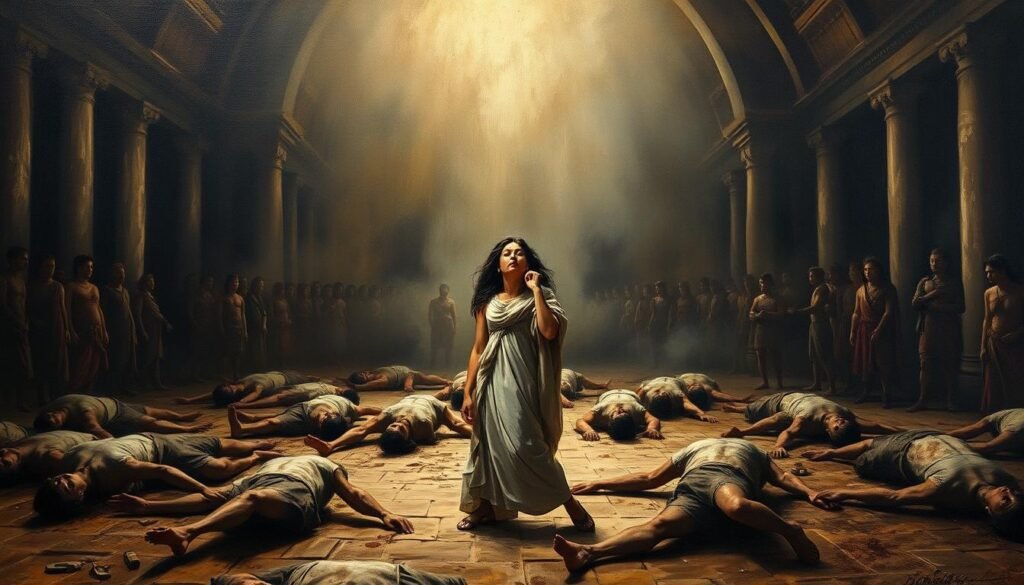
Exploring the Spoliarium and Other Masterpieces
The “Spoliarium” is a monumental work that captures the grim reality of Roman gladiators. Its dramatic use of chiaroscuro heightens the sense of dread, making it one of the most discussed pieces in arte history. Measuring 4.22 meters by 7.675 meters, it is the largest painting in the Philippines and a testament to the artist’s dedication.
Another iconic piece, “The Death of Cleopatra,” showcases the artist’s ability to blend historical storytelling with artistic brilliance. This painting earned a silver medal at the Exposición Nacional de Bellas Artes in Madrid, highlighting its international acclaim. The depiction of Cleopatra’s final moments is both poignant and powerful, reflecting the artist’s deep understanding of human emotion.
- Technical Brilliance: The intricate details and dramatic lighting in these works demonstrate the artist’s mastery of classical techniques.
- Thematic Richness: Both pieces explore themes of struggle, resilience, and identity, resonating deeply with the filipina experience.
- Cultural Significance: These masterpieces serve as reminders of the Philippines’ rich heritage and its contributions to global arte.
The enduring influence of these works is evident in modern interpretations of art. They continue to inspire artists and audiences alike, proving that great arte transcends time and borders. By preserving and showcasing these treasures, institutions like the National Museum ensure that their legacy remains alive for future generations.
National Museum’s Role in Preserving Heritage
The National Museum stands as a guardian of the Philippines’ artistic legacy. Its mission to safeguard cultural treasures ensures that the nation’s history remains alive for future generations. Through curated exhibitions, the museum brings the past into the present, offering a deeper understanding of the country’s rich heritage.
One of the museum’s key initiatives is the conservation of works that reflect revolutionary ideas. These pieces, often tied to pivotal moments in history, serve as reminders of the struggles and triumphs that shaped the nation. By preserving such artifacts, the museum honors the spirit of the revolution and its impact on Filipino identity.
The National Museum’s preservation strategies are influenced by European practices. Techniques from renowned institutions in Europe have been adapted to ensure the longevity of the Philippines’ cultural treasures. This blend of local and international methods highlights the museum’s commitment to excellence in heritage conservation.
Curated exhibitions play a vital role in educating the public. Each exposición is carefully designed to tell a story, connecting visitors to the nation’s history. These displays not only showcase artistic brilliance but also foster a sense of pride and continuity in Filipino culture.
Through its efforts, the National Museum ensures that the legacy of the revolution and other defining moments remains accessible. By preserving and sharing these masterpieces, the museum continues to inspire and educate, bridging the gap between the past and the future.
Juan Luna’s European Sojourn: Madrid, Paris, and Beyond
Europe became a transformative stage for many Filipino artists in the 19th century. Among them, one master painter’s journey through Madrid and Paris left an indelible mark on his artistic vision. This period of exploration and growth shaped his career and enriched his contributions to Philippine art.
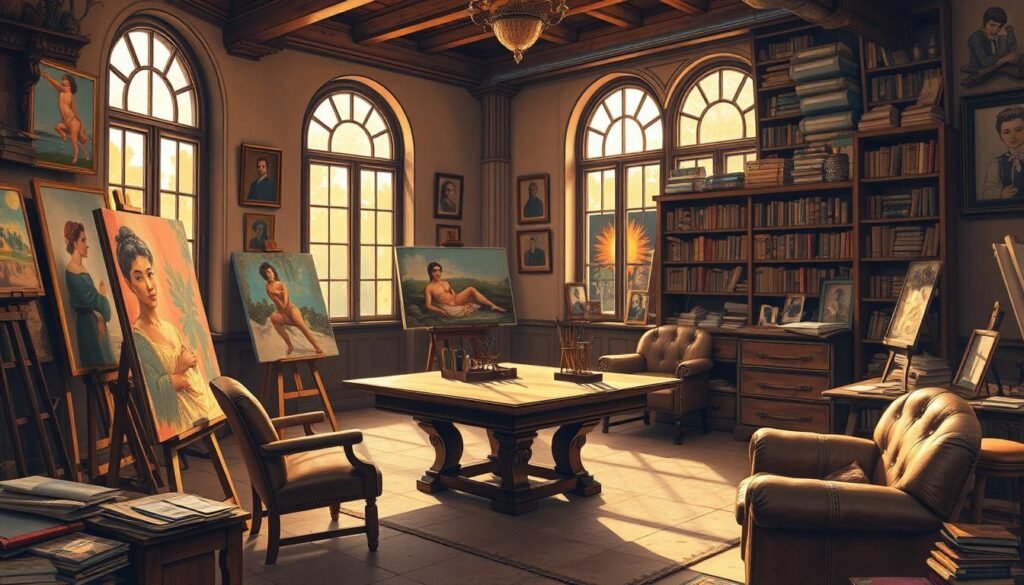
Cross-Cultural Exchanges and Artistic Evolution
In Madrid, the artist studied at the prestigious Escuela de Bellas Artes de San Fernando. Here, he honed his skills under the guidance of European masters. This training laid the foundation for his later achievements, blending classical techniques with his unique perspective.
His move to Paris marked a turning point. The city’s vibrant art scene inspired him to experiment with new styles. His studio became a hub of creativity, where he produced works that reflected both his heritage and his European influences.
The cross-cultural exchanges during this time were pivotal. He absorbed the nuances of French art, which softened his earlier Italian classicism. This evolution is evident in his later works, which showcase a harmonious blend of styles.
| Location | Key Influence | Impact on Art |
|---|---|---|
| Madrid | Classical Training | Technical Mastery |
| Paris | French Art Scene | Style Evolution |
These experiences not only shaped his art but also connected him to a broader artistic community. His time in Paris allowed him to collaborate with other artists, further enriching his creative process.
The history of his European sojourn is a testament to the power of cultural exchange. It highlights how art can transcend borders, bringing together diverse influences to create something truly unique. For more on the impact of such exchanges, explore the legacy of Filipino artists.
His journey through Madrid and Paris remains a cornerstone of his legacy. It serves as a reminder of the transformative power of art and the importance of embracing diverse influences. For further insights into the contributions of other Filipino artists, read about Roque Lopez’s pioneering work.
Triumphs, Trials, and Transformation in Juan Luna’s Life
Life’s challenges often shape an artist’s journey, leaving an indelible mark on their work. For one of the Philippines’ most celebrated painters, personal and political struggles became a defining force in his artistic evolution. His story is one of triumph, tragedy, and transformation.

Political and Social Influences on His Work
The late 19th century was a time of upheaval in the Philippines, with the Propaganda Movement advocating for reform. As a participant in this movement, the artist’s work often reflected themes of resistance and identity. His paintings became a voice for the Filipino people, capturing their struggles and aspirations.
However, his personal life was marked by turmoil. In 1892, a tragic event involving Paz Pardo Tavera, his wife, and her mother, shook his world. This incident led to a highly publicized trial, where he was eventually acquitted. The emotional toll of these events deeply influenced his art, adding layers of complexity to his later works.
Time in Hong Kong and Final Years
After the trial, the artist spent time in Hong Kong, seeking solace and a fresh start. This period allowed him to reflect on his life and work. The experiences he endured during this time contributed to his transformation as both an artist and a historical figure.
| Event | Year | Impact |
|---|---|---|
| Tragic Incident with Paz Pardo Tavera | 1892 | Personal and legal turmoil |
| Trial and Acquittal | 1893 | Emotional and artistic transformation |
| Time in Hong Kong | 1893-1894 | Reflection and renewal |
These trials not only shaped his art but also solidified his legacy as a symbol of resilience. His ability to channel personal pain into creative expression remains a testament to the power of art. For more on the evolution of Filipino visual culture, explore this detailed analysis.
Through his triumphs and trials, the artist’s journey serves as a reminder of the enduring connection between life and art. His legacy continues to inspire, offering lessons in perseverance and the transformative power of creativity.
The Intersection of Art, Revolution, and National Identity
Art has long been a mirror of society, reflecting its struggles and triumphs. In the Philippines, the works of a master painter became a powerful subject of national pride. His art not only captured the spirit of the people but also fueled the flames of revolution.
One of his most iconic pieces, the “Spoliarium,” is a testament to this. Its dramatic portrayal of oppression resonated deeply with Filipinos during a time of colonial rule. The painting’s gold medal at the Madrid Exposition in 1884 was more than an honor—it was a symbol of hope and resistance.
Art became a tool for mobilizing public sentiment. Through his work, the painter articulated messages of revolutionary change. His imagery inspired a nation to fight for its identity and freedom. This convergence of personal genius and collective identity remains a cornerstone of his legacy.
His art also served as a bridge between the personal and the political. Themes of struggle and resilience in his works mirrored the experiences of the Filipino man. These pieces became a voice for the voiceless, amplifying the call for justice and equality.
Today, his masterpieces continue to inspire. They remind us of the power of art to shape national narratives. As Rizal’s speech honoring Filipino artists highlights, art is not just a reflection of society—it is a catalyst for change.
The symbolic role of his work within the broader national narrative cannot be overstated. It stands as a reminder of the enduring connection between art, revolution, and identity. Through his legacy, the spirit of the Filipino people continues to shine like gold.
Esteemed Commissions and International Recognition
Global recognition often begins with a single masterpiece. For one of the Philippines’ most celebrated artists, prestigious commissions and international awards solidified his place in the art world. His journey is a testament to how talent and dedication can transcend borders.
Accolades at Bellas Artes and Beyond
One of the artist’s most significant achievements was winning the gold medal at the 1884 Madrid Exposition of Fine Arts. His painting “Spoliarium” not only earned this honor but also brought global attention to Filipino talent. This accolade marked a turning point in his career, establishing his name as a symbol of excellence.
Another milestone was the silver medal awarded to “La Muerte de Cleopatra” at the 1881 Exposition. This recognition highlighted his ability to blend historical storytelling with artistic brilliance. These awards underscored his talent and positioned him as a leading figure in the international art community.
| Work | Award | Year |
|---|---|---|
| Spoliarium | Gold Medal | 1884 |
| La Muerte de Cleopatra | Silver Medal | 1881 |
His name became synonymous with excellence, earning him commissions from influential institutions. For instance, King Alfonso XII commissioned him to create “La batalla de Lepanto” for the Senate of Spain. This state-sponsored project further cemented his reputation as a master painter.
Today, state and cultural institutions continue to honor his contributions. His works are preserved in renowned galleries, ensuring his legacy endures. As highlighted by Oscar Ortiz’s artistic journey, the impact of such recognitions extends beyond the artist, inspiring future generations.
These achievements not only celebrated his talent but also brought pride to the Philippines. His name remains etched in history, a reminder of the power of art to unite and inspire. Through his masterpieces, he continues to shape the cultural identity of a nation.
Comparative Perspectives: Juan Luna and His Contemporaries
The 19th century was a pivotal era for art, with artists shaping cultural narratives across the globe. Among them, one Filipino master painter stood out, leaving a legacy that continues to inspire. His work, often compared to that of his contemporaries, reflects the unique blend of bellas trends and revolutionary ideas of the time.
In 1884, the Madrid Exposition of Fine Arts marked a significant year for Filipino art. While Juan Luna’s “Spoliarium” earned a gold medal, other artists like Felix Resurreccion Hidalgo also gained recognition. This event highlighted the growing influence of Filipino talent on the international stage.
The bellas movement, characterized by its focus on beauty and technical mastery, shaped the works of many artists during this period. Luna’s style, influenced by European masters, stood in contrast to the more traditional approaches of his peers. This divergence showcased the diversity of artistic expression in the late 19th century.
October 1886 was another milestone, as Luna married Paz Pardo de Tavera, an event that influenced his personal and artistic life. This period also saw the rise of other Filipino artists who contributed to the nation’s cultural identity. Their collective achievements underscore the importance of this era in Philippine art history.
To explore the connections between Luna and his contemporaries, particularly Jose Rizal, visit this detailed analysis. Their collaboration and shared vision played a crucial role in shaping the artistic and intellectual landscape of the Philippines.
By comparing Luna’s work with that of his peers, we gain a deeper understanding of his unique contributions. His ability to blend classical techniques with revolutionary themes set him apart, ensuring his place in history as a master painter and cultural icon.
The Enduring Influence of Juan Luna on Filipino Art
The echoes of a master’s brushstrokes continue to shape the canvas of Filipino art today. His groundbreaking techniques and profound themes have left an indelible mark on the nation’s creative landscape. From modern exhibitions to art education, his legacy remains a guiding force for contemporary artists.
Legacy Reflected in Modern Philippine Art
One of the most iconic works, the Spoliarium, continues to inspire. Its dramatic portrayal of struggle and resilience resonates deeply with today’s artists. Many draw from its powerful themes to create pieces that reflect the Filipino experience.
Modern exhibitions often feature reinterpretations of his masterpieces. These displays not only honor his contributions but also highlight the evolution of Filipino art. Through these efforts, his pioneering techniques remain relevant in the 21st century.
“Art is not just a reflection of society; it is a catalyst for change.”
Art education in the Philippines also draws heavily from his work. Students study his use of light, composition, and storytelling to develop their own styles. This ensures that his influence continues to shape the next generation of artists.
The Spoliarium remains a symbol of national pride. Its themes of oppression and resilience mirror the struggles of the Filipino people. This connection ensures its place in both historical and contemporary art discussions.
Through his innovations, he helped shape a distinct Filipino art narrative. His ability to blend classical techniques with local themes set a standard for future artists. Today, his work stands as a testament to the enduring power of art to inspire and unite.
Reflections on a Pioneering Life and Career
The life of a visionary artist often mirrors the struggles and triumphs of the nation they represent. For one of the Philippines‘ most celebrated painters, his journey was a testament to resilience, creativity, and the enduring power of art. His works not only captured the essence of his time but also shaped the cultural identity of the Filipino people.
Born in 1857, his early years were marked by a passion for art and a desire to elevate his craft. His training in Europe exposed him to classical techniques, which he later blended with local themes. This fusion created masterpieces that resonated deeply with the Philippines‘ struggle for identity during colonial rule.
His later years were marked by personal and political challenges. After a highly publicized trial in 1892, he sought solace in Hong Kong. This period of reflection allowed him to channel his experiences into his art, adding layers of depth to his work. His passing in 1899 marked the end of an era but left behind a legacy that continues to inspire.
The historical significance of his death cannot be overstated. It was a moment of national mourning, as the Philippines lost not just an artist but a symbol of its cultural and political aspirations. His works, preserved in institutions like the National Museum, serve as reminders of his enduring impact.
Today, his legacy lives on in modern Filipino art. Contemporary artists draw inspiration from his techniques and themes, ensuring that his influence remains relevant. His ability to blend personal experiences with broader cultural narratives continues to shape the artistic landscape of the Philippines.
| Event | Year | Impact |
|---|---|---|
| Birth | 1857 | Marked the beginning of a legendary career |
| Trial | 1892 | Personal and artistic transformation |
| Death | 1899 | National mourning and cultural reflection |
His life and career offer valuable lessons in perseverance and the transformative power of art. As we reflect on his journey, we are reminded of the role artists play in shaping national identity. For more on his enduring legacy, explore the stories behind his masterpieces.
Conclusion
The story of a master painter’s legacy is one of resilience, creativity, and cultural pride. Luna Novicio’s contributions to art and national identity remain a cornerstone of Filipino heritage. His works, such as the iconic “Spoliarium,” continue to inspire generations, reflecting the struggles and triumphs of the Filipino people.
Born in Ilocos Norte, Novicio’s journey was shaped by his dedication to elevating Filipino art on the global stage. His ability to blend classical techniques with local narratives set a standard for future artists. Today, his masterpieces are celebrated in prestigious institutions like the National Museum, ensuring his legacy endures.
Understanding Luna Novicio’s story is essential to appreciating both historical and modern Filipino art. His works not only document history but also inspire pride and unity. To learn more about Juan Luna’s contributions, explore the depth of his impact on Philippine culture.
FAQ
Who was Juan Luna?
Juan Luna was a renowned Filipino painter and political activist during the late 19th century, celebrated for his masterpieces like the Spoliarium, which earned him international acclaim.
What is the significance of the Spoliarium?
The Spoliarium is one of Luna’s most iconic works, symbolizing the struggles of the Filipino people under colonial rule. It won a gold medal at the 1884 Exposición Nacional de Bellas Artes in Madrid.
How did Juan Luna contribute to Philippine history?
Luna’s art and activism played a pivotal role in shaping Filipino national identity. His works often reflected themes of revolution and resistance against colonial oppression.
Where did Juan Luna receive his artistic training?
Luna studied at the Academia de Dibujo y Pintura in Manila and later honed his skills at the Real Academia de Bellas Artes de San Fernando in Madrid and in Paris.
What was Juan Luna’s relationship with Ferdinand Blumentritt?
Luna and Blumentritt shared a deep intellectual and cultural bond. Luna’s gift to Blumentritt symbolizes the exchange of ideas between Filipino and European intellectuals.
Why is Juan Luna’s gift to Blumentritt important?
The gift represents a significant moment in cultural history, highlighting the connection between Filipino and European thinkers during a time of colonial struggle.
How did Juan Luna’s time in Europe influence his art?
Luna’s European sojourn exposed him to diverse artistic styles and movements, which he incorporated into his works, blending Filipino themes with European techniques.
What role does the National Museum play in preserving Juan Luna’s legacy?
The National Museum safeguards Luna’s works, ensuring his contributions to Philippine art and history are accessible to future generations.
What are some of Juan Luna’s other notable works?
Besides the Spoliarium, Luna’s notable works include The Death of Cleopatra, which won a silver medal in Madrid, and La Batalla de Lepanto, showcasing his mastery of historical themes.
How did Juan Luna’s personal life influence his art?
Luna’s experiences, including his marriage to Paz Pardo de Tavera and his involvement in the Philippine Revolution, deeply impacted his artistic expression and subject matter.
What awards did Juan Luna receive during his career?
Luna earned numerous accolades, including gold and silver medals at the Exposición Nacional de Bellas Artes in Madrid, solidifying his reputation as a master painter.
How does Juan Luna’s art reflect Filipino identity?
Luna’s works often depicted themes of struggle, resilience, and national pride, making him a key figure in the development of Filipino cultural identity.
What is the historical context of Juan Luna’s art?
Luna’s art emerged during a period of colonial rule in the Philippines, reflecting the socio-political tensions and aspirations for independence.
How did Juan Luna’s work influence modern Filipino art?
Luna’s pioneering style and themes continue to inspire contemporary Filipino artists, cementing his legacy as a foundational figure in Philippine art history.
Source Links
- JOSE RIZAL, honoring the national hero of the Philippines, 19 June 1861
- The hero of the Filipinos
- The Philippines Past and Present
- JUAN LUNA (The Philippines 1857-1899) , Parisian life
- ‘Painter as hero’: How Juan Luna first awakened the Filipino spirit
- Artworks of Juan Luna
- Juan Luna’s masterpiece – BusinessWorld Online
- Juan Luna
- Juan Luna
- In Focus: The Art of Juan Luna – National Commission for Culture and the Arts
- The Spanish Colonial Tradition in Philippine Visual Arts – National Commission for Culture and the Arts
- National Arts Month: Ambeth Ocampo shares lesser-known Juan Luna facts
- Jose Rizal [Travels]
- Juan Luna bronze bust turned over to National Museum
- Restoring the ‘Spoliarium’
- Guide to National Museum of Fine Arts in Manila – Frecelynne
- Making Revolutionary Art: Looking Back on Juan Luna’s Mastery
- Spoliarium
- Fine Arts – National Museum
- COUNTRY PAPER FOR THE WORKSHOP ON PRESERVATION OF CULTURAL HERITAGE
- JUAN LUNA Y NOVICIO (1857–1899), A Harvester Waving in Lequeitio
- Part 1
- A Filipino Painter in Paris: Juan Luna in the Field of Cultural Production
- El Golfo: A Musing Over Another Luna
- Everyday, Elsewhere: Allegory in Philippine Art
- In Focus: Suffering Colonialism: Modernity as Sacrifice and Salvation in Philippine Colonial Painting – National Commission for Culture and the Arts
- Oscar Ortiz – Official Website
- Ilham Gallery – Raden Saleh and Juan Luna – A Comparative perspective • Onarto Art Store
- Martin Arnaldo’s quest to tell the Juan Luna story sees no end – The Diarist.ph
- Juan Luna’s Masterstrokes – Filipino Art
- National Historical Commission of the Phillippines
- The Artistic Legacy of Juan Luna
- Answers to: Write an essay about Life and Works of Juan Luna
- Juan Luna’s boceto of the Spoliarium surfaces. But is it real?
- Rare paintings by Filipino masters on view in Iloilo City
- Juan Luna: A Masterful Brush that Defined a Nation’s Artistic Identity – Art Blog
- Spoliarium’ by Juan Luna: Analysis and Interpretation 551 words [Essay Example]
- Unraveling the Legacy of a Filipino Master’s Brilliant Art and Complicated Life – Enisty

